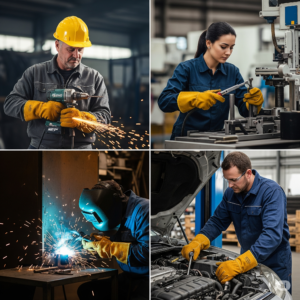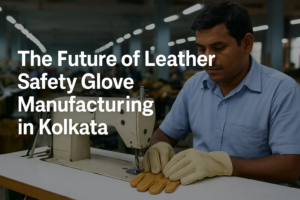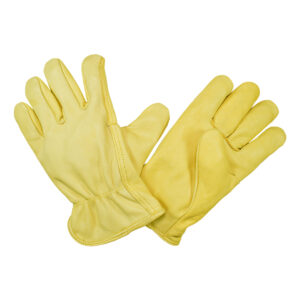
In the active and often hazardous landscape of industrial work, the hands are arguably the most vulnerable part of a worker’s body. Cuts, abrasions, punctures, burns, and impact injuries are unfortunately common occurrences. While personal protective equipment (PPE) is paramount, selecting the right type of glove for specific tasks is critical. Leather safety gloves, known for their durability, heat resistance, and excellent grip, have proven to be a cornerstone of hand protection across a multitude of industries. This article explores several case studies demonstrating how the strategic implementation of high-quality leather safety gloves has led to significant improvements in workplace safety.
1. Manufacturing Sector: Reducing Lacerations and Abrasions on Assembly Lines
A large automotive manufacturing plant faced a persistent challenge with hand injuries among its assembly line workers. Despite having a basic glove policy, the sheer volume of sharp metal edges, repetitive handling of components, and occasional exposure to hot parts resulted in frequent cuts, scrapes, and minor abrasions. These injuries led to lost workdays, increased medical costs, and a noticeable dip in morale.
Solution: The plant implemented a new safety program, centralizing on upgraded hand protection. After a thorough risk assessment, they invested in higher-grade, cut-resistant leather gloves, specifically those with reinforced palms and fingers made from durable cowhide and goatskin. Training sessions were conducted to educate workers on the importance of proper glove selection and care.
Outcome: Within six months, the plant reported a remarkable 40% reduction in hand injuries. The enhanced durability of the leather gloves meant fewer tears and increased protection against sharp objects. Workers also appreciated the improved grip, which reduced instances of dropping tools and parts, further minimizing injury risks and improving overall efficiency. The long-term cost savings from reduced injury-related expenses far outweighed the initial investment in higher-quality gloves.
2. Construction Industry: Battling Punctures, Impact, and Abrasion Hazards
Construction sites are inherently risky environments, with workers constantly exposed to rough materials, sharp objects, heavy machinery, and potential impact. A mid-sized construction company struggled with a high rate of hand injuries, including punctures from rebar, abrasions from concrete, and impact injuries from falling debris or mishandled tools.
Solution: The company revamped its PPE protocol, making it mandatory for all workers to wear specialized leather construction gloves sourced from a reputable leather hand gloves supplier in India. They chose gloves featuring strong split leather for superior abrasion and puncture resistance, often with additional padding on the knuckles and backs of hands for impact protection. The company also ensured a wide range of sizes were available to guarantee a proper, comfortable fit for all employees, recognizing that ill-fitting gloves can increase risk.
Outcome: Over an annual period, the construction company documented a significant decrease in severe hand injuries, particularly punctures and impact-related trauma. Workers reported feeling more secure and confident handling materials, leading to increased productivity. The longevity of the leather gloves also reduced the frequency of replacements, offering a cost-effective solution in the long run. This case highlighted how tailored leather gloves could offer multi-faceted protection against diverse construction hazards.
3. Welding Operations: Superior Heat and Spark Resistance
In the welding industry, extreme heat, sparks, and molten metal splashes pose severe risks to hands. A fabrication shop experienced recurring issues with minor burns and discomfort among its welders, despite using standard welding gloves. The existing gloves often showed signs of rapid deterioration under the intense heat.
Solution: The shop upgraded to premium cowhide leather welding gloves, specifically chosen for their natural heat and flame resistance. These gloves featured extended cuffs (gauntlets) to protect wrists and forearms from sparks and heat and were often lined with insulating materials like Kevlar for enhanced thermal protection. Emphasis was placed on selecting gloves with durable stitching that could withstand high temperatures without unravelling.
Outcome: The switch to specialized leather welding gloves resulted in a drastic reduction in burn incidents. Welders expressed greater comfort and confidence, allowing them to focus more effectively on their work. The superior heat resistance of the leather meant the gloves lasted longer, leading to fewer replacements and ultimately, a more cost-efficient safety solution. This demonstrated how specific properties of leather, like its inherent flame resistance, are invaluable in extreme environments.
4. Automotive Repair & Maintenance: Balancing Dexterity with Protection
Automotive technicians frequently encounter sharp tools, hot engine components, grease, and various chemicals. A small independent auto repair shop found its mechanics experiencing frequent nicks, scrapes, and chemical irritation due to inadequate hand protection. While some gloves offered good dexterity, they lacked sufficient protection, and vice versa.
Solution: The shop invested in a combination of goatskin and cowhide leather gloves. Goatskin gloves, known for their excellent dexterity and softness, were used for tasks requiring fine motor skills and tactile sensitivity, while still offering good abrasion resistance. For heavier tasks involving lifting or working with hot components, tougher cowhide gloves with reinforced areas were provided. The natural breathability of leather also reduced hand sweating and discomfort.
Outcome: The tailored approach to glove selection led to a noticeable reduction in minor hand injuries and skin irritations. Mechanics found the leather gloves comfortable enough for prolonged wear, increasing compliance. The strong nature of the leather also meant the gloves stood up better to the oils and greases common in automotive work, extending their lifespan. This case highlighted the versatility of leather in offering both strong protection and the necessary dexterity for intricate work.
These case studies unequivocally demonstrate that investing in the right leather safety gloves is not merely a compliance measure, but a strategic decision that directly impacts worker safety, productivity, and overall business profitability across diverse industries. By understanding the specific hazards and selecting appropriate leather types and designs, businesses can create a safer, more efficient, and more productive workforce.
These case studies unequivocally demonstrate that investing in the right leather safety gloves, such as those offered by Protective Leather, is not merely a compliance measure, but a strategic decision that directly impacts worker safety, productivity, and overall business profitability across diverse industries. By understanding the specific hazards and selecting appropriate leather types and designs from Protective Leather, businesses can create a safer, more efficient, and more productive workforce.









